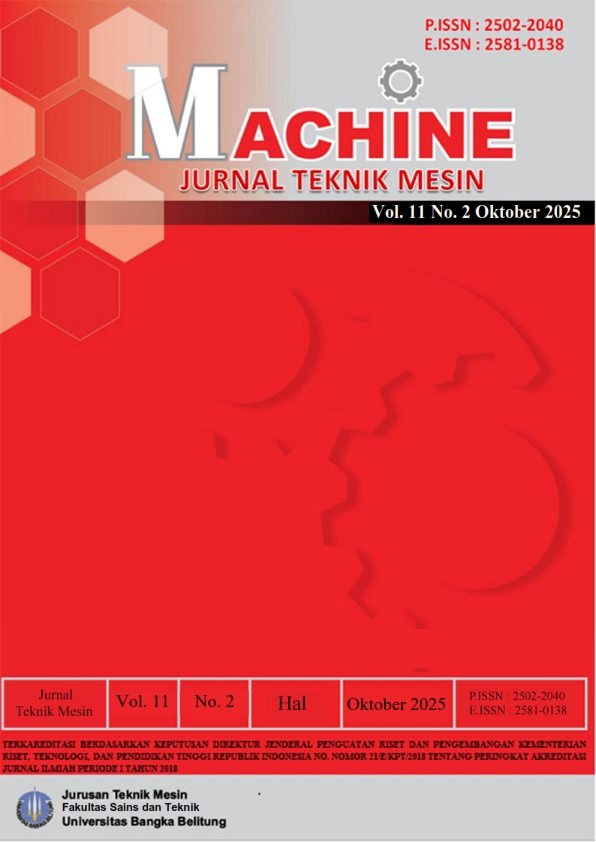Analisis Laju Perpindahan Panas pada Mesin Pengering Biji Kopi
DOI:
https://doi.org/10.33019/m98kks70Keywords:
pengeringan kopi, biji kopi robusta, debit udara, suhu pengering, perpindahan panasAbstract
Pagar Alam City, as one of the coffee-producing regions in South Sumatra, still relies heavily on traditional sun drying methods, which are highly dependent on weather conditions. The experiment was carried out by varying the air flow rate at 300, 400, and 500 liters per minute and drying air temperature at 60°C, 70°C, and 80°C. The observed parameters included the reduction of coffee bean mass, moisture content decreaseand the heat transfer rate. Supporting instruments used in this study included thermocouples, a hot wire anemometer, an RH meter, and a digital scale. The results showed that increasing both the air flow rate and drying temperature significantly enhanced the heat transfer rate and accelerated the reduction of moisture content in the coffee beans. At an air flow rate of 500 LPM and a temperature of 80°C, the highest heat transfer rate of 2,785 W was obtained, with the largest mass reduction of 534 grams from an initial mass of 2100 grams, a final moisture content of 38.93%.
Downloads
References
[1] A. Frangga, S. Jahroh, and Y. H. Asnawi, “Robusta Coffee Marketing Channel Analysis Picking Rainbows and Picking Reds in Pagar Alam City,” Int. J. Res. Rev., vol. 10, no. 12, pp. 815–823, 2024, doi: 10.52403/ijrr.20231281.
[2] M. Rohman, B. C. Tjiptady, P. Choirina, F. K. Asshidiqi, M. N. i. Humam, and M. R. Chanda, “Pemberdayaan Kelompok Tani Kopi Melalui Penerapan Mesin Sortir Otomatis Untuk Meningkatkan Produksi Pasca Panen,” J. Abdi Masy. Saburai, vol. 4, no. 02, pp. 82–90, 2023, doi: 10.24967/jams.v4i02.2474.
[3] Badan Standarisasi Nasional (BSN), SNI 01-2907-1999: Kopi Biji, Jakarta: BSN, 1999.
[4] M. I. Dzaky, E. A. Kosasih, M. B. Fauzi, A. T. Prabowo, and A. Zikri, “Activation Energy Analysis of Coffee Beans Drying Using Double Condenser Refrigeration System,” J. Phys. Conf. Ser., vol. 2377, no. 1, 2022, doi: 10.1088/1742-6596/2377/1/012058.
[5] M. I. Dzaky, E. A. Kosasih, I. I. Hakim, and A. Zikri, “Investigation of Thin-Layer Drying of Coffee Beans Using a Double-Condenser Compression Refrigeration System: Effects of Air Mass Flux, Specific Humidity and Drying Temperature,” J. Adv. Res. Fluid Mech. Therm. Sci., vol. 106, no. 1, pp. 90–103, 2023, doi: 10.37934/arfmts.106.1.90103.
[6] D. Kumaisyaroh and S. Bahri, “ANALISIS RANTAI MARKOV UNTUK PREDIKSI HASIL PRODUKSI TANAMAN KOPI DI PROVINSI SUMATERA SELATAN Markov chain Analysis for Prediction of Coffee Crop Production in South Sumatera Province,” J. Mat. Statiska dan Ter., vol. 02, no. 02, pp. 125–134, 2023.
[7] V. Holman, Heat Transfer, vol. 15, no. 3. 1999. doi: 10.1080/01973762.1999.9658510.
[8] T. Rokhman, “Menghitung Koefisien Perpindahan Panas Konveksi.” [Online]. Available: https://taufiqurrokhman.wordpress.com/tag/prandtl/
[9] Setijahartini, S. 1985. Pengeringan Agro Industri. Bogor: Institut Pertanian Bogor.
[10] Firdaus, Aneka. 2016. Perancangan dan Analisa Alat Pengering Ikan dengan Memanfaatkan Energi Briket Batubara. Palembang: Universitas Sriwijaya.
[11] S. S. T. Gultom, H. Ambarita, M. S. Gultom, dan F. H. Napitupulu,“Rancang Bangun dan Pengujian Pengering Biji Kopi Tenaga Listrik dengan Pemanfaatan Energi Surya,”
Jurnal Dinamis, vol. 7, no. 4, pp. 11–20, Des. 2019.
Downloads
Published
Issue
Section
License
Copyright (c) 2025 Machine : Jurnal Teknik Mesin

This work is licensed under a Creative Commons Attribution 4.0 International License.
The paper presented is assumed not to contain proprietary materials that are not protected by patents or patent applications. Responsibility for technical content and for protection from proprietary materials is the responsibility of the author and their organization and not the responsibility of the machine or its editorial staff. The primary author (first / appropriate) is responsible for ensuring that the article has been viewed and approved by all other authors. It is the responsibility of the author to obtain all copyright release permits required for the use of any copyrighted material in the manuscript before submission.











